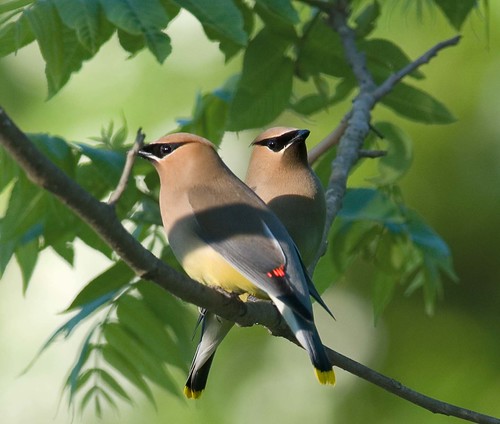 Cedar waxwings are gorgeous birds. Most of their plumage is muted brownish-grey. This doesn't sound so interesting, I know, but they're so silky-looking that their latin name, Bombycilla, comes from the Greek for silk, bombux. To add a little intrigue, their slight crest and black face mask can give them a Donnie Brasco-meets-Batman look. And then, if you can get close enough, you'll see a striking yellow bar on the bottom of their tail, and (on most birds) a few bright red dots of wax on the wings.
Cedar waxwings are gorgeous birds. Most of their plumage is muted brownish-grey. This doesn't sound so interesting, I know, but they're so silky-looking that their latin name, Bombycilla, comes from the Greek for silk, bombux. To add a little intrigue, their slight crest and black face mask can give them a Donnie Brasco-meets-Batman look. And then, if you can get close enough, you'll see a striking yellow bar on the bottom of their tail, and (on most birds) a few bright red dots of wax on the wings. Cedar waxwings rely on small fruits and berries for over 80 percent of their diet, though they supplement their spring and summer diet with insects when fruits are scarce. They travel in flocks, and a flock will often completely devour the berries of a tree before moving on to their next spot.
Cedar waxwings rely on small fruits and berries for over 80 percent of their diet, though they supplement their spring and summer diet with insects when fruits are scarce. They travel in flocks, and a flock will often completely devour the berries of a tree before moving on to their next spot.In fact, these birds have quite a reputation for gluttony. Audubon once noted that waxwings “gorge themselves to such excess as sometimes to be unable to fly...I have seen some which, although wounded and confined to a cage, have eaten of apples until suffocation deprived them of life.” Perhaps it's not surprising, then, that their courtship rituals revolve around food: the male brings a berry or an insect to a female, and they pass it back and forth several times before the female finally eats it.
We usually hear cedar waxwings before we see them. Their calls are a soft, high-pitched whistle; in a flock, the noise can be fairly continuous. This video from YouTube has a good example:
In the wild: Cedar waxwings like forest edges. Their numbers are actually increasing, possibly because suburban landscapes offer lots of edge-like habitat. Keep an ear out for their whistling, and an eye out for large flocks of birds eating tree fruits.
In your yard: The best way to attract cedar waxwings is to plant native trees and shrubs that bear small fruits, including dogwood, serviceberry, cedar, hawthorn, cherry, winterberry, holly, mulberry, chokecherry, and hackberry. Research has found that more than half of cedar waxwing nests are in either maple or cedar trees.
More info:
Cornell Lab of Ornithology: Cedar Waxwing
Waxwing Lyrical: Flying with Icarus and Daedelus
Smithsonian Migratory Bird Center
Like the photos in this post? Mouse over for credits; a click takes you to the photographer on Flickr.


